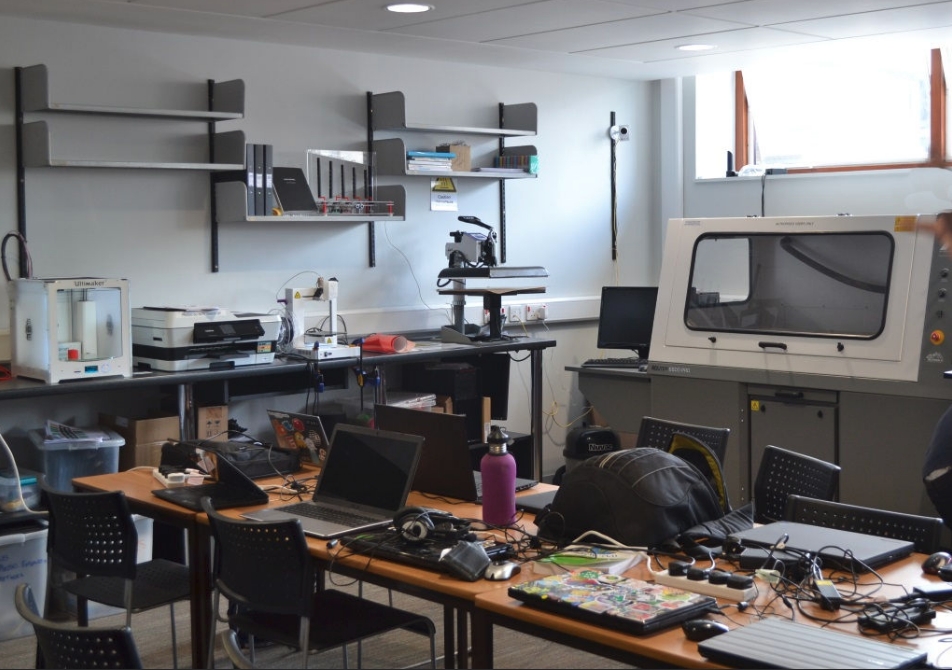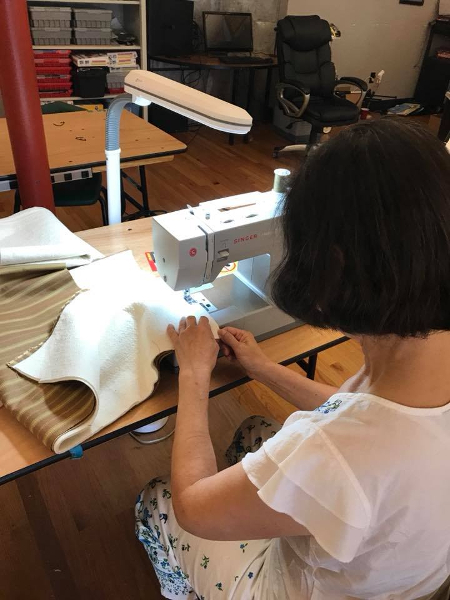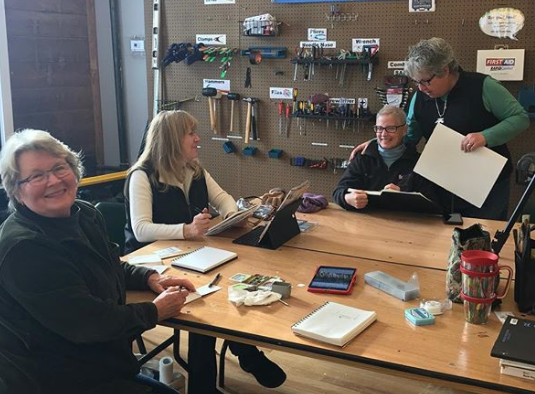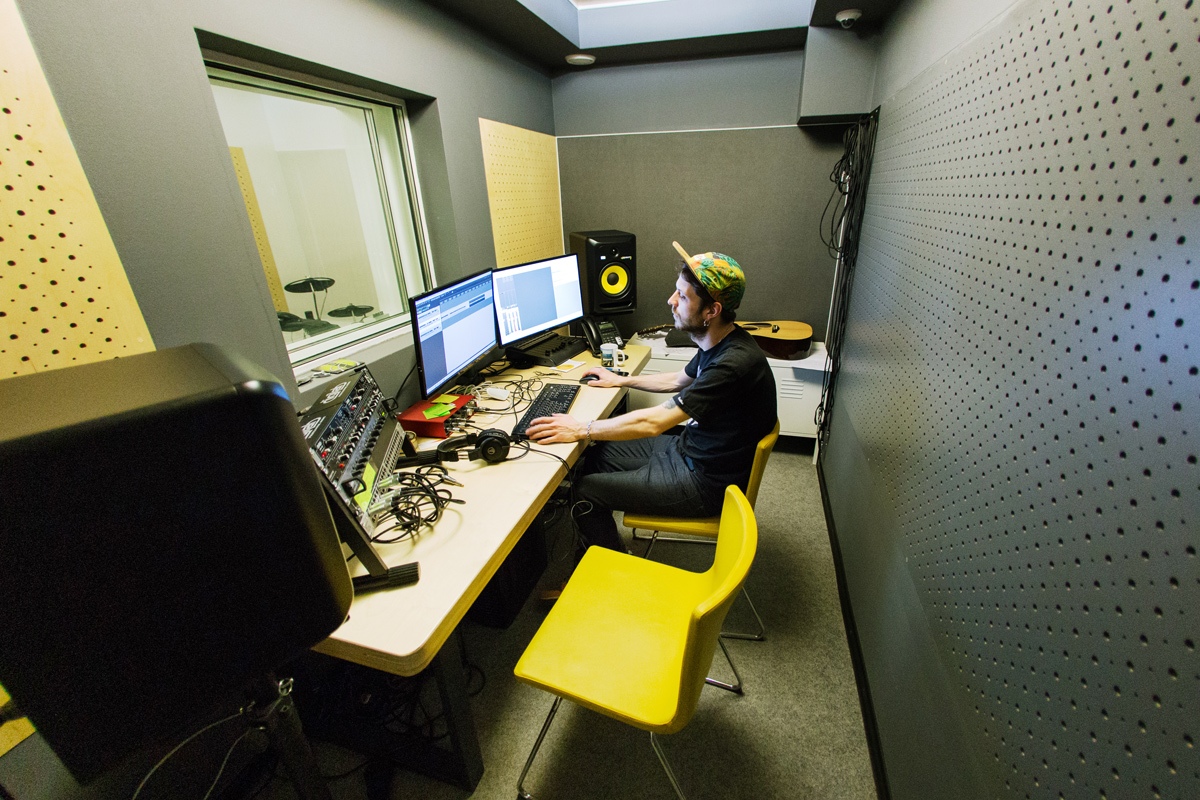Craft - to the library

Workshop in Exeter Library. Photo source
Libraries are losing value as a repository of knowledge, because this role today monopolizes the Internet. But to abolish their society is not yet ready, because it is an important cultural symbol. In order not to be a “suitcase without a handle,” libraries have to become something else, rethink their work and take on new functions. One of these possibilities is the concept of a “third place”: a space where people spend time other than home and work / study.
Handmade in trend
"Third place" is often clubs, coffee shops, time-cafes and other places with a carefully created atmosphere of comfort. In second place are sports clubs, fitness centers, yoga studios, stretching, dancing. To take a place in this row, libraries work in two directions: they change the organization of space and offer new, more popular types of activities, besides reading and attending lectures and film screenings. One of the most popular is the organization of workshops at libraries where you can do different hand-made.
Hobbies associated with manual labor, are extremely popular in developed countries. This phenomenon is explained by the fact that many people here are busy working at the computer. Therefore, they like to create real, tangible things with their own hands. When libraries organize equipped workshops where you can sew, knit, draw; make crafts from wood, leather, paper. And also try yourself in the "craft" at the junction of manual labor and computer technologies: laser engraving, working on a CNC machine and 3D printing. Such workshops are similar to coworking, but instead of computers and laptops there are sewing machines, engravers, carpentry tools and 3D printers.
')

A volunteer in the library of Fayetteville sews bedding for a dog shelter. Photo source
In the US, the program for equipping libraries with 3D printers has been implemented for seven years, and quite successfully: they have appeared in more than 400 institutions, and in many libraries, not one, but 2-4 devices. Other countries adopt experience.
Why 3D printing?
Some modern 3D printers for the price is already more affordable than the flagship smartphones. But in the minds of most people, they remain expensive and complex, and bulk printing is not a hobby for everyone. Libraries take on the mission to popularize additive technologies and give everyone basic knowledge of them.
Advantages for visitors - in availability. Like other services, 3D printing workshops in libraries are inexpensive for visitors. So, in Fayetteville Free Library (Fayetteville, New York) you only need to pay for consumables, and renting a printer is free. And in The Smithtown Library (New York) the fare is 25 cents per 15 minutes of printing.
Most large municipal libraries are located in the city center, which makes it easy to get to them.
Pluses for libraries - in the influx of new audiences, which can be involved in other activities. And in the ability to follow its main mission: to be an accessible educational resource for people of all social strata.

Workshop in the central library of San Diego. Photo source
Four hundred workshops in five years
The 3D workshop deployment program in US libraries works quite efficiently. The ALA (American Library Association) brochure , which answers basic questions about the organization of workshops, says that by May 2016, the Association had 428 libraries with 3D printers.
It is known that the first volumetric printing workshops in public libraries began to appear in 2011 (the pioneer was the Fayetteville Free Library, USA). In 2013, Riel Gallant, the author of the site www.3ders.org , conducted a study “3D printing in libraries around the world”, searching for information in a search engine and on the websites of institutions. According to him, 51 libraries announced the purchase of a 3D printer, and 25 of them had already opened access to equipment to the general public. According to the results of his research, he mapped a map , which from time to time supplemented up to 2016.

District of Columbia Public Library. Photo source
The pace of development is impressive: 51 points - in the first two years and about 370 more - in the next three. There are no statistics for 2018, but in ALA publications, 3D printing is mentioned as one of the most popular services in libraries.
Barbara M. Jones, one of the directors of the American Library Association, has published an article on 3D printing. According to her, teaching the people of this technology, the library realizes their constitutional right to freedom of expression. It also contributes to education (students can create engineering projects) and helps with vocational guidance, laying the knowledge base on digital design.
It sounds pompous, but how does the work on teaching 3D printing in libraries work in practice?

Idaho librarians are taught how to work with printers. Photo source
Fayetteville Free Library (FFL)
The library in Fayetteville, New York, was a pioneer in 3D printing. The first printer appeared here seven years ago. Now there are four of them in the library workshop (Mojo and Flashforge), plus a plotter, laser cutting equipment, a CNC machine, and sewing machines. There are also Kraft mechanical tools (a press for buttons, scissors, knives, pliers, hammers), irons, stationery and much more. All equipment is integrated into the FFL Fab Lab. This is one of the two laboratories of the library, along with the Digital Creation Lab - a workshop for recording and editing video.
Every FFL visitor can come to the labs for an excursion. And any registered reader - to work with the equipment. But first pass the "certification": listen to instructions or watch a training video. For each type of printer, as well as for the laser engraver, a separate certification is needed; a note about its passage is placed in the library card.
A “certified” library client can book a 3D printer for hours that are convenient for him. You do not need to pay rent - only consumables (5 cents per gram of plastic for Flashforge and $ 6 per cubic inch for Mojo).
To rent a 3D printer for a class or group, you will also need to pay rent to the audience.

Fayetteville Library Workshop
The city library
The City Library of The City Library in Adelaide, the capital of Australia’s southern coast, calls itself a “multi-functional space.” There is a media studio, several classes with office equipment, a place for an exhibition, a reading room, an impressive collection of books and an Innovation Lab. In the latter, Australians can get acquainted with robotics, virtual reality and 3D printing.
The library is equipped with a MakerBot Replicator printer. To work with him, you need to sign up for one of the "sessions" - an hour and a half training with a volunteer teacher. Study group - four people; you need to bring a file with a 3D-model and, if possible, a laptop.
You can “book” the printer in advance at a convenient time, but the duration of the session also does not exceed 1.5 hours. And there is always a volunteer on it.
Entresse Library

Photo source
The Entresse Library in Espoo (Finland) is part of the municipal network HelMet, which unites book storages in the metropolitan area: the cities of Helsinki, Espoo, Kauniainen and Vantaa. Finnish libraries are famous for the fact that in addition to issuing books, they provide a large package of services. These are translation of documents, enrollment in free language clubs in Finnish and English, co-working rent and rental of everything in the world, from musical instruments to construction and repair equipment.
The Entresse Library also has a workshop - a room where you can use equipment for creativity. There are laptops, sewing machines, an apparatus for applying prints on a T-shirt and a 3D printer.
To print your project, you need to reserve equipment through the site. There are six printers for bulk printing in the library: three copies of Ultimaker 3 and the same number - Ultimaker 2+. The service can be used only by registered library users who have login information. The maximum rental period is 11 hours. If difficulties arise, a library employee will always help, who is always in the workshop.
Youth Library

Photo source
It is good to see that Russian libraries (at least, large ones) are also becoming modern. For example, the Russian State Library for Youth in Moscow has a convenient site and several electronic services, and she was the first Moscow library to start getting into the role of the “third place”. Now there are courses on graphic design and amateur cinema; a platform for young musicians is launched (open stage); Contests and festivals are held.
One of the most popular spaces is Media LAB, a creative laboratory for self-education in the field of IT. Here you can study engineering graphics programs, listen to lectures on programming, use a graphics tablet, an electronic magnifying glass, a reading scanner and a 3D printer. So far there is one device for bulk printing, Picaso 3D Designer. The fare for printing models is 40 rubles per cubic centimeter. The service is available to all visitors; Since the Youth Library is a federal institution, any citizen of Russia can come here, regardless of registration. It is only necessary to take with you an identification document and issue a library card (permanent or one-time).

It will be possible to study popular models of 3D printers and get a basic knowledge of 3D printing at 3D Print Expo in Sokolniki (October 12-13). Participants will see a large exhibition of equipment and software (about 60 stands), master classes in modeling, drawing with 3D pens and a lecture hall.
Source: https://habr.com/ru/post/421643/
All Articles